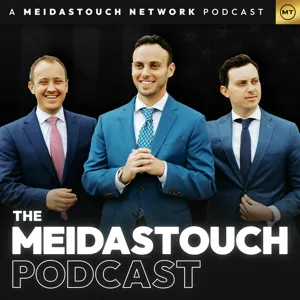Podcast Summary
Ireland's Celtic Tiger era and its impact on art and culture: During periods of significant economic growth, societal norms and artistic expression can be influenced, leading to extravagant displays and a sense of naivety.
The economic prosperity of a society can significantly influence how people behave and produce art, as exemplified during Ireland's Celtic Tiger era. During this period of unprecedented wealth, there was a sense of naivety and excess, with people buying unnecessary items like cars, decking, and even helicopters. This expression of silliness was evident in various aspects of Irish culture, including nightclubs with chocolate fountains and fire dancers. This era serves as a reminder of how economic conditions can shape societal norms and artistic expression.
Culture of excessive spending and irrational behavior during Ireland's Celtic Tiger economic boom: During the Celtic Tiger economic boom in Ireland, people spent exorbitantly on seemingly ridiculous things due to a belief in endless wealth and a lack of access to information.
During the Celtic Tiger economic boom in Ireland, there was a culture of excessive spending and irrational behavior. People would drink expensive, gold-infused liquors like Goldschlager, believing that the gold was slitting their throats and getting them drunk faster. This behavior was accepted and even bragged about, despite the absurdity of the belief. The ostentatious displays of wealth, such as private jets flying in DJs and helicopters landing on apartment rooftops, created an environment where people were willing to spend exorbitant amounts of money on seemingly ridiculous things. The belief in endless wealth and the naivety of the population allowed this culture to thrive, even though it was based on a false premise. The lack of access to information through the Internet also played a role in perpetuating these beliefs.
During irrational times, people's consumption choices reflect societal conditions: In periods of irrational wealth expression, people's consumption behaviors are influenced by societal conditions, with examples ranging from medieval Europe's dancing skeletons to modern-day gold consumption and Bitcoin mining.
During periods of irrational wealth expression, people's choices of consumption reflect the societal conditions around them. For instance, during the Celtic Tiger era, young men in Limerick nightclubs consumed gold, paracetamol, and even defecated gold. Now, in a different context, they brag about having solar panels and mining Bitcoin. This behavior can be traced back to medieval Europe where entire towns danced themselves to death, and death was depicted as a dancing skeleton leading the rich in art. As an artist and academic, I'm fascinated by these strange patterns and the conditions that led to them. This week, I'll explore the relationship between dancing and death in 13th century Europe, focusing on the unique depictions of death as a dancing skeleton leading the rich.
A reminder of death's indifference to wealth during the Black Death: Despite the Black Death causing massive deaths among the rich and powerful, art depicting death continued to be commissioned by them, emphasizing death's indifference to social status.
The depiction of death dancing with the wealthy during the late medieval period served as a humble reminder that no one, regardless of social status, is immune to death. This was a time when the Black Death, the worst pandemic in human history, was spreading, causing people to die in massive numbers, including the rich and powerful. The art that survived was created by patrons, who were wealthy, and thus the depictions of death spoke to this audience rather than the poor. The Black Death was caused by bacteria carried by fleas on rats and was a disease of globalization and early capitalism. The loss of a third of Europe's population in a short period caused widespread fear, stress, and uncertainty. Additionally, during this time, there was natural climate change, which contributed to the collective stress through the end of the medieval warm period and the beginning of a mini ice age.
Little Ice Age: Devastating Famine and Hardships in Europe: The Little Ice Age caused widespread famine from 1315 to 1317 due to crop failure and lack of sun, leading to cannibalism, diseases, revolts, civil wars, and a split in the Catholic Church.
The cooling period around 1250, known as the Little Ice Age, had devastating effects on Europe. This period caused widespread famine from 1315 to 1317 due to crop failure and lack of sun. The rain prevented crops from ripening and created a salt shortage, leading to food scarcity and inflation. During this time, cannibalism became a reality due to extreme hunger. The famine also led to diseases, revolts, civil wars, and even a split in the Catholic Church. Art from this era often depicted death as a dancing skeleton. Stories like Hansel and Gretel and the Pied Piper of Hamelin emerged during this time, reflecting the harsh realities of this period in European history.
The Pied Piper's role in protecting against the plague: During the medieval period, the belief that dancing could protect against the plague led to the Pied Piper's role as a refugee leader using music and bright clothes.
During the medieval period, the Pied Piper was a person who led refugees away from famine-stricken Europe using music and bright clothes. However, an intriguing theory suggests that the Pied Piper's role may have been connected to the understanding of medicine during that time. According to this theory, the symptoms of the plague were believed to be caused by an imbalance of the four humors in the body. The plague was considered a blood disease, and blood was associated with being outgoing and healthy. Therefore, engaging in life-giving activities like dancing was thought to protect against the plague and keep death at bay. Interestingly, unexplained and uncontrollable dancing became a pandemic in the late medieval period, which could be linked to this belief. So, the Pied Piper's role as a refugee leader might have been intertwined with the belief that dancing could protect against the plague.
Mass psychogenic illnesses in late medieval period: Historically, societal pressures and stress led to infectious-like spread of behaviors, emphasizing community impact. Support independent creators like podcasts through Patreon for editorial control and sustainability.
During the late medieval period, certain behaviors spread like infectious diseases among groups of people, leading to what are now known as mass psychogenic illnesses. These illnesses were characterized by the rapid spread of symptoms and behaviors, such as meowing like a cat or uncontrollable dancing, affecting entire communities. These behaviors had no organic cause but were instead a response to stress and nervous excitement. The podcast host shared this historical phenomenon as a way to highlight the power of community and the impact of societal pressures. The host also shared that his podcast is his sole source of income and encouraged listeners to support him through Patreon. He emphasized that this model is based on kindness and generosity, with listeners paying what they can afford, even if it's just the price of a pint or a cup of coffee. By supporting the podcast, listeners help keep it fully independent and allow the host to maintain editorial control over its content.
Mass hysteria and uncontrollable dancing in the Middle Ages: The dancing plagues of the Middle Ages were unexplained mass behavioral phenomena causing people to dance uncontrollably until death. Possible causes include collective trauma, stress, and hallucinogenic substances. Well-documented due to genre painting, likely spread through word-of-mouth, and occurred post-Black Death.
The dancing plagues of the Middle Ages were mass behavioral phenomena that spread across Europe, causing people to dance uncontrollably until they died. These events occurred in various places and time periods, including Erfurt in 1247, Strasbourg in 1518, and others. The causes are still debated, but it's believed that they were linked to collective trauma, stress, and potential hallucinogenic substances. The phenomenon was well-documented due to the popularity of genre painting during that time, which depicted normal people in their everyday activities. Despite some theories suggesting that ergotism, a mold found on rye and wheat, was the cause, it's more likely that the dancing plagues spread through word-of-mouth and were a form of mass hysteria or trauma response. These events occurred in the aftermath of the Black Death, which had decimated Europe's population, leading to widespread fear, uncertainty, and religious fervor.
Irrational responses to change and stress throughout history: Humans have a deep-rooted tendency to respond irrationally to change and stress, as seen in historical examples like the dancing pandemics and modern trends like the Celtic Tiger phenomenon.
Throughout history, humans have responded to significant changes and stressors in irrational ways that can spread like viral pandemics. The example given is the dancing pandemics during the late medieval period, where people danced themselves to death due to collective hysteria. This behavior can be compared to modern irrational trends or fads, such as the Celtic Tiger phenomenon where people drank gold-infused drinks despite knowing it was nonsensical. The humans in these historical periods and modern times are biologically the same, suggesting that our irrational responses to change and stress are deeply ingrained in our nature. This insight raises questions about how we as a society handle change and stress in the present day and what potential irrational trends or pandemics might emerge in the future.
The connection between dancing skeletons and pandemics: Despite uncertain times, find joy and distraction, and remember the importance of health insurance
The connection between artistic depictions of dancing skeletons and dancing pandemics, though seemingly unrelated, is rooted in cultural significance. This intriguing topic is just one of many that the speaker plans to explore in upcoming podcast episodes. In the meantime, the speaker encourages listeners to find joy and distraction in the present, even amidst uncertain times. A reminder that despite the changes that may come in the next few years, such as the potential rise of chatbots as companions, the need for health insurance remains constant. UnitedHealthcare TriTerm Medical plans offer flexible and budget-friendly coverage for those in between jobs or who missed open enrollment, providing peace of mind for the unexpected. For more information, visit uhone.com.




